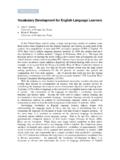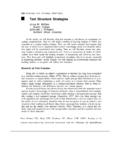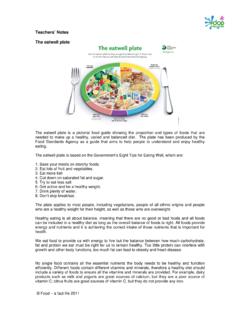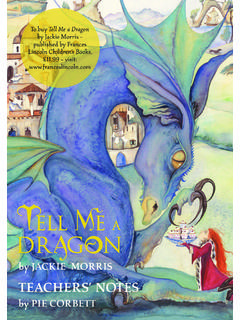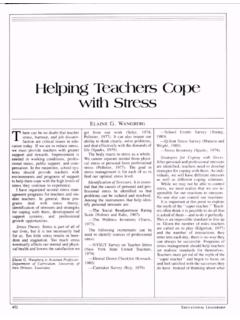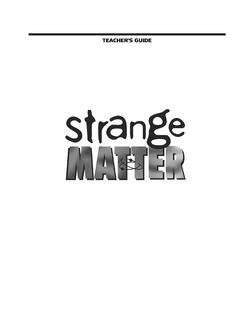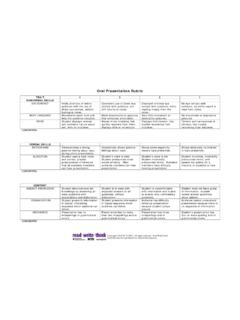Transcription of KWL In Action: Secondary Teachers Find …
1 Table of Contents KWL In action : Secondary Teachers find Applications that Work Donna M. Ogle National-Louis University Knowledge that becomes ours is knowledge that we construct. This quotation attributed to Henry David Thoreau expresses the theme of this paper. Both Teachers and students need models and opportunities to construct meaning. As Teachers we need to employ classroom instructional strategies that facilitate students construction of their own meanings. Research has made quite clear the importance of the active, constructive nature of reading and learning; good learners link their prior knowledge to new information, reorganize it and create their own meanings (Anderson, 1984; Steffenson, Joag-Dev, & Anderson, 1979; Taboada & Guthrie, 2006).
2 The KWL strategy, described in this paper, is designed to help readers do just that. KWL provides a framework for learning that can be used across content areas to help students become active constructors of meaning. Teachers also need opportunities to learn and use new strategies until they make them their own adapting strategies to their own situations and teaching needs. Therefore, after explaining the KWL+ strategy, examples for a team of three high school Teachers who have adapted the strategy illustrate how Teachers , too, learn through an interactive process and construct personal meaning. KWL + Strategy Explained The letters in the name, KWL, stand for the process of making meaning that begins with what students KNOW, moves to the articulation of questions of what they WANT TO KNOW, and continues as students record what they LEARN.
3 The strategy is designed to be used by a teacher and group of students working together. It is then easily transferred into a method for students independent study. In using the strategy the teacher first leads the group through an oral discussion of each of the components and then turns the process over to students to individually write their own ideas and questions on a personal worksheet. (For an example see Figure ) The intent of the strategy is to involve students actively, first by making real the connection between their prior knowledge and the information that will be presented in the texts, both by eliciting what they know about the specific information and the ways that information is likely to be structured. Then Teachers guide the students to think of questions they need and want to have answered and, finally, students make notes and then organize the old and new information in graphic and elaborated written form.
4 K-W-L Strategy Sheet From Ogle (1996) NAME_____ SUBJECT_____ 1. K - What We Know W - What we Want to Learn L - What We Learned and Still Need to Learn 2. Categories of Information We Expect to Use A. D. G. B. E. H. C. F. I. Figure As Teachers initiate a new topic or prepare students to read an article or chapter, they explain the strategy that is being used. Teachers may say: It is important to first find out what we think we know about this topic. Then we want to anticipate how an author is likely to present and organize the information. From this assessment we can generate good questions to focus our reading and study. Our level of knowledge will determine to some extent how we will study. Then as we read we will make notes of questions that get answered and other new and important information we learn.
5 During this process some new questions will probably occur to us; these we should also note so we can get clarification later. After a brief explanation the teacher and students identify what they think they know about the topic; the teacher writes student-brainstormed ideas on the board or overhead transparency. All ideas should be recorded it is not the teacher s role at this time to clarify misconceptions, simply to let students first articulate the associations they have with the topic, right or wrong. As students engage in this brainstorming some questions should begin to emerge. Not everyone should have the same ideas; some disagreements and misconceptions begin to surface. The teacher notes these differences and helps students frame them into questions.
6 These then become the beginning of the second column, what we want to know. As the teacher facilitates the brainstorming of ideas and elicits questions that will guide the reading, she is modeling the writing of ideas and framing of questions for students who have a difficult time taking risks and composing their own questions. As soon as the teacher feels students are ready, she suggests that each now write on their own sheet what they individually think they know in the know column and the 2-3 questions that are of most interest to them in the second column. With less motivated students, selecting questions from those modeled by the teacher may provide a basic level of commitment to the learning. Some Secondary students have learned that not engaging in class activities protects them; such students may need more structure and familiarity with the process before they will be willing to ask their own questions.
7 At first these students may simply be allowed to select the 2-3 questions they think are most likely to be answered from those the teacher has modeled. Another important component of the pre-reading preparation is anticipating the organization and structure of ideas that authors are most likely to use. This aspect of pre-reading taps a different kind of knowledge that is important for learning. The bottom of the first column on the worksheet provides space for students to list anticipated categories or topics. Secondary students need to be able to identify descriptive organization, compare-contrast, cause-effect, sequence, and argumentation basic organizing structures used in written and oral discourse in our society (see Roller, 1990, for further elaboration). An easy and very common structure is a simple descriptive frame with categories of information on a topic provided one by one.
8 (For example, a chapter or book section on animal biology often adheres to a simple descriptive frame discussing animals, class by class, with information organized by categories basic description, location, means of protection, and value in the natural cycle.) Other texts may compare and contrast animals or deal with functional systems and use animals for examples. These organizations require higher order thinking and yet assume knowledge of basic categories of information. If students are not familiar with categorizing and structuring information, Teachers can model this kind of thinking from the initial brainstorming students do by asking, How do you think the author of a text or article on _____ is likely to organize the information?
9 What categories or topics would you expect to find ? If no ideas are forthcoming the teacher can direct students attention to the list of information they generated. This list can then be used to help students identify like ideas that could be chunked into a single category. For example, during a pre-reading discussion of coelenterates (corals and jellyfish) students may have suggested information like the following: live in salt water, have soft bodies, eat small creatures, wait for food to come to them, and are simple animals. The teacher can help students identify the more general categories represented by this information: habitat, physical characteristics, eating, and scientific classification. These categories should not be difficult for Secondary students to generate once they are attuned to thinking of organization of knowledge.
10 Yet, it is surprising how few students will use these organizers if not led to do so by Teachers . The time spent focusing students thinking about likely structure is important whether the KWL is used as a framework for reading a chapter or to initiate a broader unit of exploration and study. Too often content Teachers assume students know how to use larger organizing structures for learning; asking students to anticipate most likely structures assures that we don t overlook gaps in students strategic thinking and provides us a naturally occurring occasion to teach these structures. These structures also have tremendous value when students come to study and write. Having organizing frames consciously available empowers students to chunk together discrete pieces of information in meaningful and, thus, memorable ways.

